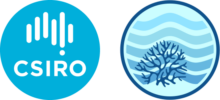Biogeochemistry – GBR4
The biogeochemical model consists of 10 dissolved, 22 living particulate, 11 non-living particulate, and 6 epibenthic state prognostic variables. In addition to the prognostic variables there are 40 diagnostic variables (such as primary production). Below, selected surface values are shown as stills and animations for the NRT GBR4 BGC model for the whole model domain, and 3 regions (Burdekin, Tully and Fitzroy). For a listing of all model variables see Appendix A of the eReefs models technical report.
Chlorophyll
In the model, total chlorophyll a is the sum of chlorophyll a concentration of the four microalgae types (large and small phytoplankton, Trichodesmium and microphytobenthos). The below stills and animations show surface concentrations.
Large phytoplankton chl a, small phytoplankton chl a, Trichodesmium chl a, total chl a
Whole GBR4 grid – still / animation
Cape York – still / animation
Wet Tropics – still / animation
Burdekin Whitsundays – still / animation
Fitzroy and Burnett-Mary- still / animation
Carbon chemistry
Total alkalinity (AT) is the concentration of ions that can be converted to an uncharged species by a strong acid. The model assumes AT = [HCO3–] + [CO32-], often referred to as carbonate alkalinity. Alkalinity and DIC together quantify the equilibrium state of the seawater carbon chemistry.
Alkalinity, pH, Dissolved Inorganic Carbon (DIC), and aragonite saturation state
Whole GBR4 grid – still / animation
Cape York – still / animation
Wet Tropics – still / animation
Burdekin Whitsundays – still / animation
Fitzroy and Burnett-Mary- still / animation
The eReefs modelling team has had a paper published in Nature Communications using this model: MONGIN, M., BAIRD, M. E., TILBROOK, B., MATEAR, R., LENTON, A., HERZFELD, M., WILD-ALLEN, K. A., SKERRATT, J., MARGVELASHVILI, N., ROBSON, B., DUARTE, C. M., GUSTAFSSON, M. S. M., RALPH, P. J. & STEVEN, A. D. L. 2016. The exposure of the Great Barrier Reef to ocean acidification. Nature Communications (in press).
Particulates
Inorganic particulates includes fine inorganic sediment and organic particulates included biologically active deritus from phytoplankton and macrophytes.
Inorganic and Organic
Whole GBR4 grid – still / animation
Cape York – still / animation
Wet Tropics – still / animation
Burdekin Whitsundays – still / animation
Fitzroy and Burnett-Mary- still / animation
Inherent and apparent optical properties (IOPs and AOPs)
Inherent Optical Properties (IOPs) of the water column are calculated from the model biogeochemical state (phytoplankton biomass, particulate concentrations etc). These include the absorption and scattering properties of clear water, colour dissolved organic matter, suspended solids and each microalgal population.
IOPs: Vertical light attenuation (490 nm), total absorption (440 nm), total scattering (550 nm), vertical short wave attenuation
Whole GBR4 grid – still / animation
Cape York – still / animation
Wet Tropics – still / animation
Burdekin Whitsundays – still / animation
Fitzroy and Burnett-Mary – still / animation
From the calculation of the IOPs and the surface light field, apparent optical properties (AOPs), such as remote-sensing reflectance, can be determined, and compared to remotely-sensed products. The remote-sensing reflectance is a measure of the water-leaving radiance normalized by the at-surface downwelling solar irradiance and has units of sr-1. Thus both model outputs and observations can be quantified as a remote-sensing reflectance. To avoid confusion, we will use the term observed remote-sensing reflectance to refer to satellite-derived Rrs, and simulated remote-sensing reflectance to refer to Rrs calculated from the outputs of the biogeochemical model.
The calculation of simulated remote-sensing reflectance introduces a novel means of model assessment – simulated true colour. The simulated surface reflectance at the red, green and blue wavelengths are processed using the MODIS true colour protocols to produce simulated true colour images of the water surface, with features such as bottom reflectance, river plumes and microalgal blooms easily characterised by their colour.
AOPs: Remote-sensing reflectance at 470 nm, 555 nm and 645 nm, and simulated true colour
Whole GBR4 grid – still / animation
Cape York- still / animation
Wet Tropics – still / animation
Burdekin Whitsundays – still / animation
Fitzroy and Burnett-Mary- still / animation
The eReefs modelling team has published a paper on the use of the remote sensing reflectance and true colour produced by the eReefs biogeochemical model. BAIRD, M. E., CHERUKURU, N., JONES, E. M., MARGVELASHVILI, N., MONGIN, M., OUBELKHEIR, K., RALPH, P. J., RIZWI, F., ROBSON, B., SCHROEDER, T., SKERRATT, J., STEVEN, A. D. L. & WILD-ALLEN, K. A. 2016 Remote-sensing reflectance and true colour produced by a coupled hydrodynamic, optical, sediment, biogeochemical model of the Great Barrier Reef, Australia: comparison with remotely-sensed data Environmental Modelling and Software 78, 79-96.
Hindcast links – animations
Visualising the hindcasts is primarily done through the visualisation portal. But here we just highlight a few particular outputs from the GBR4 biogeochemical hindcast.
The comparison between remotely-sensed chlorophyll and simulated chlorophyll is made robust by calculating the simulated OC3. Simulated OC3 is the calculated chlorophyll concentration based on the MODIS OC3 algorithm using the simulated remote-sensing reflectance at 3 wavelengths.
4 year model surface simulation and remote sensing chlorophyll comparisons
Palm Passage transect: nutrients, chlorophyll
Fitzroy River transect: nutrients, chlorophyll
Cairns transect: nutrients, chlorophyll
